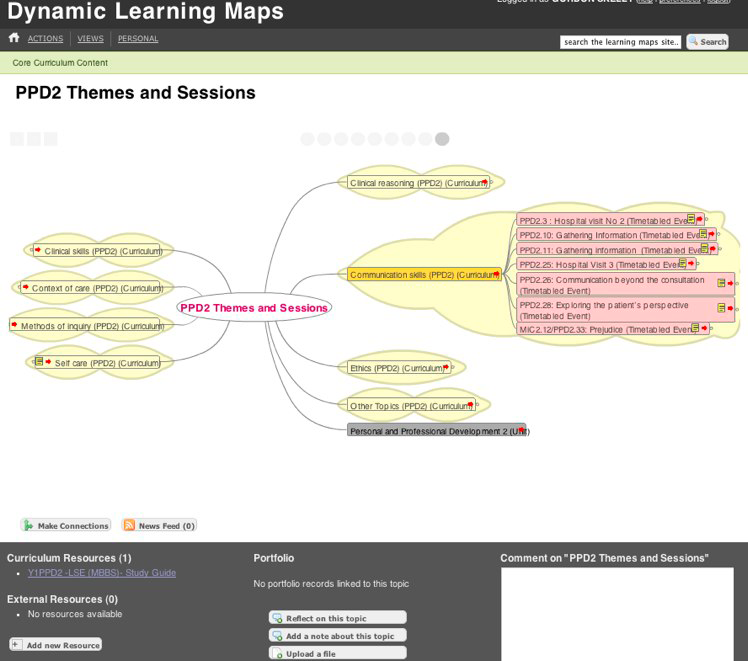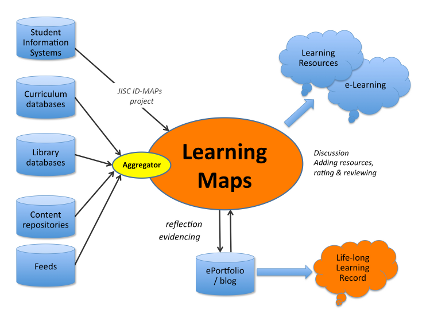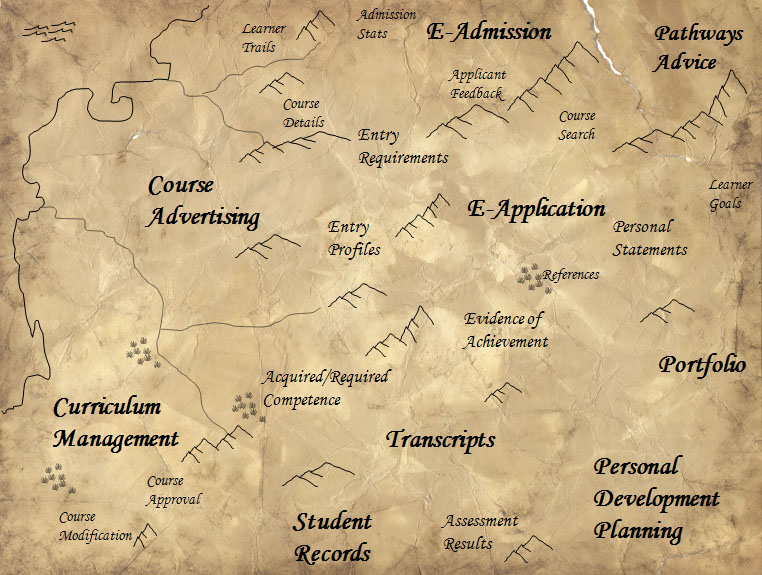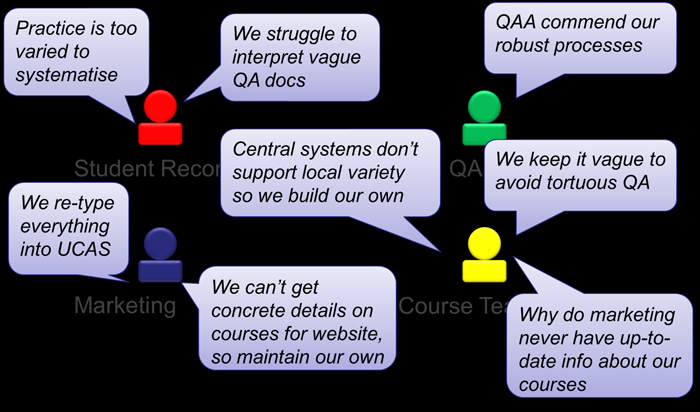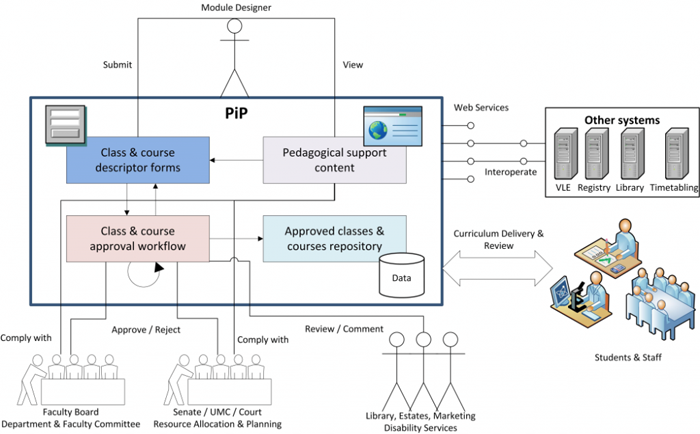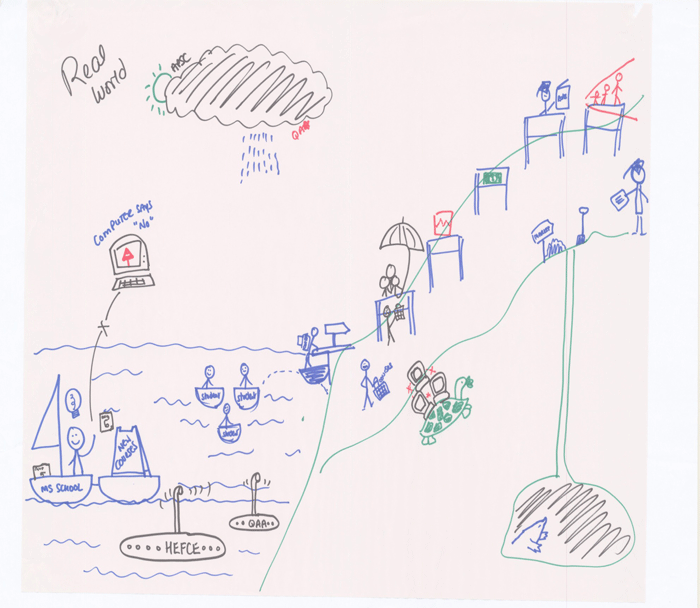A CETIS perspective of the OER story
One of the advantages of having being involved with JISC for a number of years (as a project and a service) is the opportunity to reflect on some activities that we’ve been involved in for some time. We thought it would be interesting to take the long view of some of our involvement with OER, XCRI, Learning Environments and reflect on what has worked and why, and where we think these activities are going next.
This first story looks at the development of the Open Educational Resources area. Lou McGill talked to Phil Barker and Lorna Campbell about how the OER field has evolved in the last ten years.
Open Educational Resources
CETIS has been engaged with technical aspects of educational resource management and use since its early days. This includes contributing to the development and implementation of standards and technologies for creating and making learning resources discoverable [1], managing and sharing learning resources [2] and technologies for learning design [3]. Each of these areas has a rich history of activities and technological development. In 2008, following on from involvement in the areas of open access to research [4] and open technologies [5], CETIS highlighted the potential of open content for learning and teaching and how this might challenge and transform approaches to educational practice [6]. The term Open Educational Resources (OERs) emerged in the early 2000s and can be understood broadly to mean “digitised materials offered freely and openly for educators, students and self-learners to use and reuse for teaching, learning and research” (OECD, 2007). Since then the UK has seen considerable activity relating to OERs and more recently in open educational practices (OEP). The CETIS wiki [7] has a section dedicated to the technical aspects of OERs providing background information and links to further resources.
How we got here…
JISC funded OER activities in the UK have been shaped by the history of learning resources in national Further and Higher education contexts and by what we have learned from a number of development programmes. The OER and JISC CETIS timeline[8] has been developed to illustrate the various activities that make up the learning resources and OER landscape and includes JISC and CETIS activities since 2002. It also highlights some wider national and international initiatives which illustrate trends and changes in the last decade.
JISC CETIS and OER timeline in tikitoki
Historical perspective in the UK
Cultural aspects and practices around sharing learning resources have been a particular focus for several UK studies [9], [10], [11] and continue to be a focus for UKOER activities. JISC has funded a number of programmes since 2002 to investigate issues around developing, managing and accessing learning resources, and these have surfaced issues relating to institutional policies and practices, business models, teaching practices, legal issues and technical aspects. In addition to providing technical and strategic support and guidance to the programmes, CETIS contributes to scoping the technical requirements and reports on wider trends across the decade.
JISC funded a large scale programme in the early 2000s called eXchange for Learning (X4L) (2002-2006) [12] to support the development, repurposing and sharing of learning resources. This ran in parallel to the establishment of a national learning resources repository Jorum [13]. Following on from X4L the RePRODUCE Programme (2008-2009) [14] focussed on developing courses using repurposed and re-usable learning resources. In the mid to late 2000s JISC funded two other programmes focussed on establishing technical infrastructure within institutions and across the sector – Digital Repositories (2005-2007) [15] and Repositories and Preservation (2006-2009) [16].
These programmes were informed by a strategic and technical vision which was expressed through initiatives including the e-Learning Framework [17], the e-Framework [18], the Information Environment Technical Architecture [19] and the Digital Repositories Roadmap [20].
Projects in the X4L programme were required to explore the process of integrating interoperable learning objects with VLEs. A small number of tools projects were funded to facilitate this task: an assessment management system (TOIA), a content packaging tool (RELOAD) and a learning object repository (Jorum). Projects were given a strong steer to use interoperability standards such as IMS QTI, IMS Content Packaging and IEEE LOM. A mandatory application profile of the IEEE LOM was developed for the programme and formal subject classification vocabularies identified including JACS and Dewey. Projects were strongly recommended to deposit their content in the Jorum repository and institutions were required to sign formal licence agreements before doing so. Access to content deposited content in Jorum was restricted to UK F/HE institutions only.
These conditions meant that projects required significant support to engage with and implement the various standards and invested considerable time on these elements. Depositing learning and teaching materials in formal repositories raised very different issues to that of depositing research outputs, as these included a wide range of formats, levels of granularity and sometimes incorporated accompanying pedagogical guidance. A particular focus for projects and the wider community at this time was the debate about how granularity of learning resources impacted on aggregation/disaggregation and how this affected flexibility and reuse. The X4L review report highlighted the fact that repurposing and reuse are affected by much more than granularity
“Effectively ease of use, improving the learning experience, and improving design are all interrelated, and all will be underpinned by an understanding of who will actually engage in repurposing (or reuse) and why.[21]“
Several X4L projects encountered problems with resources that incorporated items with various original licences, and highlighted the fact that teachers had often not previously acknowledged ownership of content they had used or understood the need to do so. The JISC programmes in the mid 2000s did much to challenge the perceptions within the community that licencing and copyright was overly complex, but did little to generate positive attitudes towards this and remove barriers.
“the licences used, and hence the access authorization policy for the JORUM repository, focussed more on restricting access and use than on permitting it.” Phil Barker
CETIS and another JISC Innovation Support Centre, UKOLN [22], were funded to run the Repositories Research Team, as part of the JISC Digital Repositories and Repositories and Preservation Programmes. The remit of this team included: helping projects find and exploit synergies across the programme and beyond, gathering scenarios and use cases from projects, liaising with other national and international repositories activities, including liaison with the e-Framework, synthesizing project and programme outcomes, and engaging with interoperability standards activity and repository architectures. This team were able to draw together key messages from the programmes [23].
Whilst there was an increase in institutional repositories providing access to scholarly works at this time, there was less success supporting and facilitating access to teaching and learning materials. One of the final conclusions of the Repositories and Preservation Advisory Group, which advised the JISC repositories programmes, was that teaching and learning resources had not been served well by the debate about institutional repositories seeking to cover both open access to research outputs and management of teaching and learning materials, as the issues relating to their use and management are fundamentally different [24].
The late Rachel Heery also commented that greater value may be derived from programmes that focus more on achieving strategic objectives (e.g. improving access to resources) and less on a specific technology to meet these objectives (e.g. repositories). An example of this kind of approach is the International JISC/NSF Digital Libraries in the Classroom Programme (2003-2008) [25] which investigated institutional, technical and social aspects to developing, sharing and managing content to support learning activities. Projects in this programme were led by academic departments and focussed on the strategic objectives of using the content with learners. Although specific technologies and standards were not mandated for this programme, projects brought together formal repositories, workflows, copyright, metadata issues and learning design with web 2.0 approaches, tagging, digital literacies and student content, all within real learning and teaching contexts.
Rather than a radical shift in policy these conclusions should be regarded as reflecting a gradual development in policy, licensing and technology right across the web.
Wider context
The emergence of a highly networked ‘social web’ has impacted on how people find, create, manage, share and use content, for both personal professional and learning activities. This includes the advent of web 2.0, the appearance of media specific dissemination platforms such as slideshare, youtube, flickr, iTunesU, interaction through RESTful APIs, OpenID, OAuth and other web-wide technologies, and increasing acceptance of Creative Commons licenses. These services and changing practices are not always open and, it could be argued, openness is not always appropriate. So whilst the open web and the social web are not co-dependent there is a move towards open social web approaches to learning and teaching, of which moocs (Massive open online courses) are one example [26]. This is transforming how learners interact with educational content and is challenging traditional models of educational provision and scholarly activities. This affects institutional policies and strategies, particularly around technologies to support learning and teaching.
“As a result there has been a movement away from developing centralised education specific tools services and towards the integration of institutional systems with applications and services scattered across the web. Furthermore there has been growing awareness of the importance of the web itself as a technical architecture as opposed to a simple interface or delivery platform.” Lorna Campbell. Phil Barker and R. John Robertson
This has been reflected in recent JISC funded programmes where specific technologies and standards are not mandated and projects are encouraged to adopt technologies that suit their purpose and context.
Internationally, various models have emerged to release open content. These models are often shaped by how they have been funded and by the various, and sometimes quite different, motivations to release content as OERs. Community based models offer sustainable approaches based on practice and resources sharing, whilst some educational institutions recognise the potential of OERs as marketing opportunities. Recent initiatives such as University of the People [27] and OER University [28] reflect both the fundamental aspiration of providing access to learning for students around the world as well as a need for educational institutions to find ways to respond to changing needs of learners. Issues around accreditation and assessment in an open context are emerging as an important focus for the community. Activities have predominantly concentrated on releasing OERs with less focus on how these are being used, or who is using them, although the increasing focus on open learning experiences, and the fact that there is now a significant corpus of OERs, is starting to change this. Technologies are increasingly being utilised to track use and feed relevant content to individuals and has been a focus of recent activities in UKOER projects.
Moving towards open in the UK
The launch of the Open University OpenLearn [29] and the University of Nottingham’s u-Now Open Educational Repository [30] in the mid 2000s marked the UKs first formal steps with OERs, although individual academics and teachers were experimenting with open technologies to make some of their content openly available [31]. Despite these, and other international initiatives, the RePRODUCE Programme concluded that projects had significantly underestimated the difficulty of finding high quality teaching and learning materials that were suitable for copyright clearance and reuse. In 2008 JISC funded a research study [32] into the sharing of learning materials which provided a history of sharing and managing learning resources in the UK, described business models and benefits, and focussed on open and community sharing. This report concluded that open approaches to producing and making learning materials accessible was likely to have significant impact on both the sharing and exchange of resources in both national and global contexts. Also in 2008 CETIS produced a briefing paper on OERs and held a scoping session at their annual Conference. These reports fed into the development and scoping of the jointly funded HE Academy/JISC UKOER programme [33].
The UKOER Pilot Programme (2009-2010) involved a range of OER providers including individual educators, discipline-based consortia and institutions.
Given this diversity it was recognised from the outset that no single technical solution would fit all projects, and therefore no specific tools, descriptive standards, exchange or dissemination mechanisms were mandated (apart from a requirement that the resources produced be represented in a national repository of learning materials). [34]
CETIS has supported this diversity by encouraging discussions at meetings or through blog posts to identify which technical choices have been made by individual projects, recording these openly [35] and responding to issues as they arose.
Where we are now…
The UKOER programme has progressed through phase two into phase three and Jorum has continued to be developed as an open national repository with CETIS providing input on issues around bulk upload of resources and syndication. Projects have highlighted a range of technical issues relating to building collections, and providing rich descriptions, of learning resources. CETIS has been involved in supporting this by exploring issues around packaging, describing, tracking and aggregating resources. Project technical approaches have included RSS aggregation and techniques similar to podcasting, presentation of resources through novel interfaces such as timelines and maps using geolocation data; representation of relationships between resources cross search, upload and metadata harvesting through the use of third party host APIs. As well as supporting projects, CETIS provided opportunities to discuss these issues with the wider community at its annual conferences [36] and other events.
An important aspect of CETIS’s work is that of providing a unique space for technically focussed staff to have conversations across institutional boundaries and also offering opportunities for innovation and experimentation. A joint CETIS/UKOLN DevCSI OER Hack Day event proved to be highly productive and stimulating as it brought together software developers, project managers, academics, learning technologists, researchers and users to work in multi-disciplinary teams on ideas for developing tools and solutions to OER problems. Towards the end of 2011 CETIS commissioned two technical OER Mini-projects which adopted the rapid innovation funding model and aimed to encourage openness and innovation. This provides a contrast to longer term large scale programmes [37].
The CETIS team blogs continue to provide an ongoing dialogue around technical issues, identifying emerging trends as well as providing programme level synthesis. There has been a value in taking a team approach to programme support as CETIS staff brought a wealth of experience from their involvement with the earlier JISC funded work around learning resources and repositories. CETIS staff who have been involved in this area include Lorna Campbell, Phil Barker, R. John Roberston, Li Yuan, Sheila MacNeill and Sarah Currier.
“Although we have seen a significant shift in focus from formal repository standards, protocols & procedures, learning objects and controlled access to repositories to lightweight web-wide specifications and social sharing platforms, there is still plenty to discuss regarding resource description, levels of openness, resource discovery, student content and quality” [38]. Phil Barker
Even during the relatively short timescale of the UKOER programme CETIS has seen projects choose a wide range of solutions to increase access to their OERs. During phases 1 and 2, projects released resources of varying levels of granularity from individual images to whole courses. Many projects used multiple platforms [39] to host these and some projects made their OERs available on a combination of national, institutional and subject repositories, social sites and content management systems. Projects were encouraged to use feeds to ensure that resources stored on different hosts were displayed on other sites, which is in marked contrast to the early X4L content and increases visibility and access to the OERs. Projects were aware that the range of different potential users needed different levels of granularity, levels of additional content, metadata and presentation methods. It is interesting to see projects take advantage of the affordances of formal repositories such as more effective content management, version and licence control and metadata, and balancing these with the informal web-based approaches which appear to offer flexibility and choice, tagging and commenting, although repositories are increasingly offering similar functionality.
Where we are going…
CETIS will continue to work with the UK HE and FE community to encourage discussion, innovation and experimentation with technologies and standards to support OERs and open practices, and to feed this into broader national and international contexts. In 2010, in the US, the Learning Registry was established as an international open source technical system offering an alternative approach to learning resource discovery and sharing and as a community for people sharing resources [40]. This initiative seems to exemplify how far the learning and teaching community has come in the last decade in terms of aspirations and approaches. It remains to be seen how successful the technical approaches will be, but Lorna Campbell, Assistant Director at CETIS sees the potential…
If the Learning Registry is successful in creating a “light-weight learning resource information sharing network” it will be a major step forward in terms of facilitating access to the wealth of educational content that is scattered across the web. Lorna Campbell
CETIS advise JISC about the Learning Registry and also advise the JISC JLeRN project [41] which is the experimental node in the UK.
Codebashes, hack days and the annual CETIS conference events provide spaces for JISC funded projects and the wider community to extend the conversations into new areas and continue innovation. The third phase of UKOER will continue to provide real-use studies of a range of different technologies and standards [42] and includes some interesting work with publishers. As the educational community worldwide focuses on open accreditation and assessment, and on digital literacies to produce and use OERs the CETIS team is likely to have a role in drawing together different communities to cross boundaries and share knowledge and experience from other aspects of work.
About Lou
Lou McGill is currently working independently and has recently been involved in synthesis and evaluation activities for the HE Academy/JISC UKOER programme and the JISC Transforming Curriculum Delivery Through Technology programme. She lead the team that produced the Good Intentions report on business cases for sharing and worked on the LLiDA study (Learning Literacies in a Digital Age). She has experience of working in a range of HE institutions as a librarian, learning technologist and project manager and used to be a JISC Programme Manager on the eLearning team. In the distant past she worked for NIACE (the adult learning organisation) and in Health education for the NHS. Her interests and experience include digital literacy, information literacy, open education, distance learning, managing organisational change, and effective use of technologies to support learning. Further information on Lou’s work can be found at: http://loumcgill.co.uk
